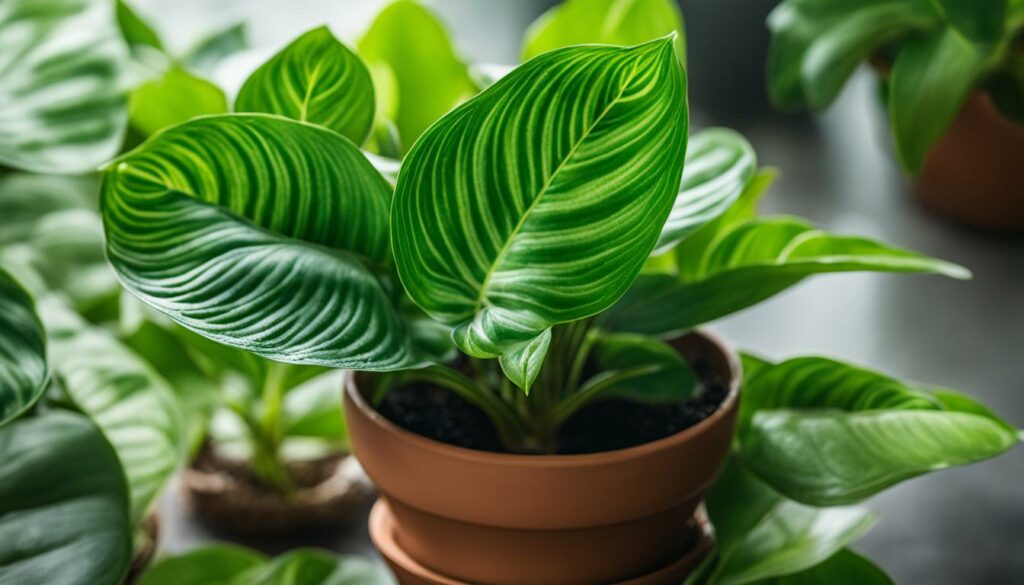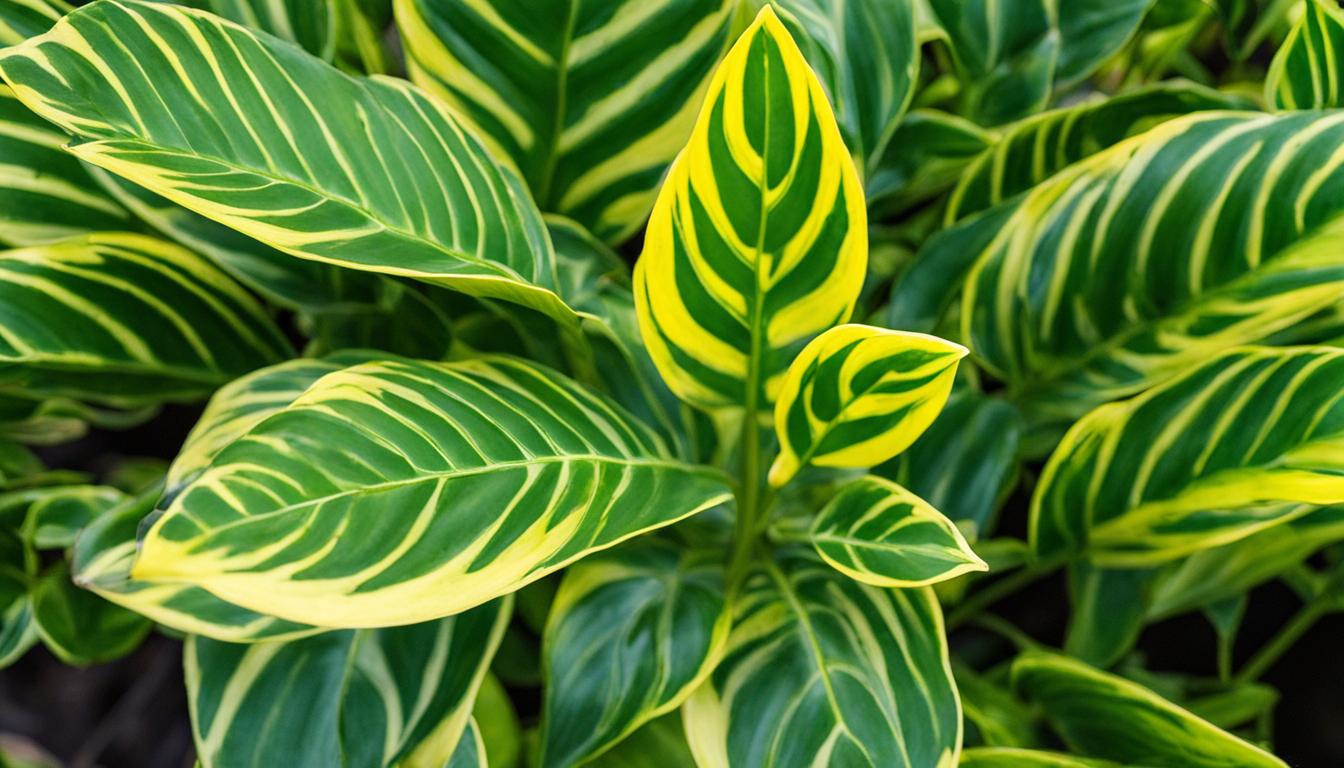Welcome to our comprehensive guide on propagating Green Prayer plants! If you’re looking to expand your collection or share these beautiful houseplants with others, you’ve come to the right place. In this article, we will walk you through different methods for propagating Green Prayer plants, providing you with valuable tips along the way.
Green Prayer plants, also known as Maranta leuconeura, are popular for their strikingly painted leaves and captivating patterns. By learning how to propagate these plants, you can easily create new ones and enjoy the process of watching them grow.
We will explore two primary methods of propagation: stem cuttings and propagation in water or soil. Each method has its own advantages, and by following our step-by-step instructions, you’ll be able to successfully propagate Green Prayer plants in no time.
Whether you’re a seasoned plant enthusiast or just starting your green journey, this guide will equip you with the knowledge and techniques needed to propagate Green Prayer plants effectively. Let’s get started!
Propagation by Stem Cuttings: A Simple and Effective Method
One common method of propagating Green Prayer plants is through stem cuttings. This technique is simple and effective, allowing you to expand your collection or share the plants with fellow enthusiasts. To propagate using stem cuttings, follow these steps:
- Start by selecting a healthy stem with leaves.
- Identify the nodes along the stem, as they are crucial for root development.
- Make a clean cut just below the node using sharp shears.
- You can choose to propagate the cuttings in water or directly in soil.
If propagating in water, place the cutting in a glass container with room-temperature water. Submerge the node while keeping the leaves above water. Change the water weekly, ensuring it is at room temperature. Cover the cutting with a clear plastic bag and place it in indirect sunlight. Once the roots reach a length of 1-2 inches, you can transfer the cutting to a pot.
If propagating directly in soil, fill a pot with a suitable potting mix. Dip the cutting in rooting hormone to encourage root development. Plant the cutting in the pot, ensuring the node is covered but the leaves remain exposed. Water the cutting thoroughly and provide it with indirect sunlight. Keep the soil moist while the new plant grows, adjusting the watering frequency according to the season.
Benefits of Stem Cutting Propagation:
Stem cutting propagation offers several advantages for Green Prayer plant enthusiasts:
- Easy and cost-effective method
- Allows for the creation of multiple new plants
- Can be done indoors
- Provides an opportunity to share plants with others
By following these propagation tips, you can successfully expand your Green Prayer plant collection using stem cuttings. Whether you choose to propagate in water or soil, remember to provide the right environmental conditions and care for the new plants to ensure their healthy growth.
Propagation in Water: Watching Roots Grow
In the process of propagating Green Prayer plants, one effective method is propagation in water. This method allows you to witness the growth of the roots, making it an exciting and rewarding experience. To begin, fill a glass container with room-temperature water. Choose a healthy cutting from the plant, ensuring that it has at least one node. Place the cutting in the container, making sure the node is submerged in water while the leaves remain above. This will encourage the development of roots.
It is important to change the water in the container once a week and ensure that it is at room temperature to provide the ideal environment for root growth. Cover the cutting with a clear plastic bag to create a humid atmosphere and place it in an area with indirect sunlight. This will help stimulate root development. Be patient and keep an eye on the cutting as it begins to form roots. Once the roots have reached a length of 1-2 inches, you can transfer the cutting to a pot with soil.
Propagation in water is a simple and effective method for propagating Green Prayer plants. It allows you to closely observe the growth of roots and ensures a higher success rate compared to other methods. So, if you’re looking to expand your collection of Green Prayer plants indoors, give propagation in water a try and enjoy the excitement of watching roots grow.
Table: Comparison of Different Propagation Methods
| Propagation Method | Advantages | Disadvantages |
|---|---|---|
| Propagation in Water |
|
|
| Propagation in Soil |
|
|
Propagation in Soil: Strong Roots for Long-Term Growth
When it comes to propagating Green Prayer plants, one effective method is propagation in soil. This technique allows the plant to develop strong roots for long-term growth and ensures successful establishment in its new environment. Here are some tips and steps to follow when propagating Green Prayer plants in soil.
Dip the Cutting in Rooting Hormone
Prior to planting the cutting in soil, it is beneficial to dip the base of the stem in rooting hormone. This hormone stimulates root development and increases the chances of successful propagation. Simply dip the cut end of the stem into the rooting hormone powder, ensuring it is well coated, and gently tap off any excess.
Planting the Cutting in the Pot
Choose a pot with drainage holes and fill it with a suitable potting mix. Create a small hole in the soil using your finger or a pencil, and carefully place the cutting into the hole, making sure the node is covered with soil while the leaves remain exposed. Gently press down the soil around the cutting to secure it in place.
Watering and Care
After planting the cutting, give it a thorough watering to settle the soil and provide moisture for the roots to grow. It’s important to keep the soil consistently moist but not overly saturated. Monitor the moisture levels and adjust the watering frequency accordingly. Place the pot in a location with indirect sunlight to promote growth without exposing the plant to harsh direct sunlight.
| Propagation Method | Advantages | Disadvantages |
|---|---|---|
| Propagation in Soil | Strong root development, long-term growth | Takes longer for roots to establish |
| Propagation in Water | Quick root growth, easy to monitor | Requires regular water changes, potential for rot |
By following these steps and providing adequate care, your propagated Green Prayer plant should develop strong roots and thrive in its new pot. Remember to monitor the soil moisture, provide appropriate lighting conditions, and be patient as the roots establish themselves. With time and care, you can enjoy the beauty of your newly propagated Green Prayer plant.

Transplanting and Care: Establishing Healthy Green Prayer Plants
Once you have successfully propagated your Green Prayer plants using stem cuttings in either water or soil, it’s time to transplant them and provide the care they need to thrive. Transplanting is an important step in establishing healthy plants that will continue to grow and bring beauty to your indoor space.
Start by selecting individual pots with suitable potting mix for each propagated plant. Transplant the plants carefully, making sure the roots are covered but the leaves remain exposed. This will give the plants the support they need while allowing the foliage to receive light.
Place the transplanted Green Prayer plants in a bright spot with indirect sunlight. These plants thrive in medium to bright light conditions, but direct sunlight can cause their leaves to scorch. Ensure that the temperature is suitable for their growth, typically ranging from 60 to 80 degrees Fahrenheit.
Water your Green Prayer plants regularly, keeping the soil consistently moist but not soggy. Overwatering can lead to root rot, so it’s important to find the right balance. You can also create a humid environment for your plants by misting their leaves or placing the pots on trays filled with pebbles and water. This will help replicate their natural tropical habitat.
To promote healthy growth, fertilize your Green Prayer plants every two weeks during their active growth period. Use a balanced houseplant fertilizer diluted to half the recommended strength. This will provide the necessary nutrients without risking fertilizer burn.
By following these transplanting and care guidelines, you will be able to establish healthy Green Prayer plants that will continue to thrive and add beauty to your indoor space. Remember to monitor their growth, make adjustments to their care as needed, and enjoy the rewards of successfully propagating these stunning houseplants.
| Transplanting and Care Tips: |
|---|
| Choose individual pots with suitable potting mix |
| Transplant carefully, ensuring roots are covered and leaves are exposed |
| Place in a bright spot with indirect sunlight |
| Keep soil consistently moist, avoiding overwatering |
| Create a humid environment by misting leaves or using trays with water and pebbles |
| Fertilize every two weeks during active growth |

Conclusion: Expand Your Green Prayer Plant Collection
Propagating Green Prayer plants is an exciting and cost-effective way to grow your collection or share these stunning houseplants with others. By following our step-by-step guide, you can successfully propagate Green Prayer plants using stem cuttings in either water or soil.
Remember to provide the right environmental conditions and care for your newly propagated plants to ensure their healthy growth. Green Prayer plants thrive in bright spots with indirect sunlight, so find the perfect spot in your home to showcase their beauty.
Watering is essential for the growth of your Green Prayer plants. Keep the soil moist but not soggy, adjusting the watering frequency based on the season. Additionally, providing a humid environment by misting the leaves or using trays filled with pebbles and water can enhance their well-being.
Regular fertilization every two weeks during active growth will help your Green Prayer plants thrive. With these tips for propagating Green Prayer plants, you can expand your collection and enjoy the beauty of these unique houseplants.
FAQ
Can Green Prayer plants be propagated from stem cuttings?
Yes, stem cuttings are a common and effective method for propagating Green Prayer plants.
How do I propagate Green Prayer plants using stem cuttings?
Select a healthy stem with leaves and cut just below a node. You can propagate the cuttings in water or soil.
Can Green Prayer plants be propagated in water?
Yes, you can propagate Green Prayer plants in water by placing the cutting in a glass container with room-temperature water.
How do I propagate Green Prayer plants in water?
Fill a glass container with room-temperature water, place the cutting in the container with the node submerged, and change the water weekly. Once the roots reach 1-2 inches in length, plant the cutting in a pot.
Can Green Prayer plants be propagated in soil?
Yes, you can propagate Green Prayer plants in soil by planting the cutting in a pot with a suitable potting mix.
How do I propagate Green Prayer plants in soil?
Fill a pot with a suitable potting mix, dip the cutting in rooting hormone, and plant it in the pot with the node covered. Keep the soil moist while the new plant grows.
How do I transplant and care for propagated Green Prayer plants?
Once the roots have established, transplant the propagated Green Prayer plants into individual pots with a suitable potting mix. Place them in a bright spot with indirect sunlight and water regularly. Provide a humid environment and fertilize every 2 weeks during active growth.



